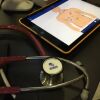After seeing a number of inquiries about the potential uses for CPAP in COVID-19 treatment, we reached out to EMS1 contributors from the Montgomery County Hospital District, Robert Dickson, MD, FAAEM, FACEP, FACEM, MCHD medical director; and Casey Patrick, MD, MCHD assistant medical director, to get their take.
“The bottom line is to avoid all nebs in patients who are not in frank respiratory failure – and, if you have to give them – do it “in line” with NIV, only if you have the proper kit with filter,” Dr. Dickson noted. Read more: Airway management adjustments in the era of COVID-19
CPAP, or Continuous Positive Airway Pressure, is a popular therapy for CHF and other common respiratory emergencies. It helps patients inhale while delivering PEEP, or Positive End Expiratory Pressure. This combined with supplemental oxygen help patients breathe easier and often prevents progressive worsening of the respiratory emergency.
Today we have three basic types of CPAP delivery systems:
- Combination ventilator with CPAP
- CPAP standalone device
- Disposable CPAP systems
Disposable CPAP devices have become popular for several important reasons. They are compact and lightweight. In rural areas, where CPAP treatments may be infrequent, they are affordable because they eliminate the need for any capital equipment. They also make a great choice for first responders. Finally, they allow for faster ER turnaround time. You can simply transfer the patient with a disposable CPAP to a wall oxygen flowmeter and clear the ER quickly.
We have recently seen the introduction of quite a few new disposable CPAP systems, giving EMS providers many disposable CPAP devices to choose from. The first popular disposable in EMS was the Boussignac CPAP.
The Boussignac CPAP device is an oxygen-powered disposable PEEP valve and mask assembly. It provides expiratory pressure support generated by the flow of oxygen from a standard regulated oxygen source.
It can provide CPAP of 5-10 cm by using 15-25 lpm of oxygen. It creates a “virtual PEEP valve,” so to increase the PEEP, you simply turn up the oxygen flow rate.
It also provides substantial oxygen enrichment. Since it is an open system, patients can always freely inhale. This feature acts like a built -in safety to prevent inspiratory restriction.
The new O-Two Medical Technologies’ single-use Open CPAP Device offers similar benefits. Like the Boussignac device, the O-Two device uses oxygen flow as a PEEP generator. You can also easily attach a nebulizer inline.
Another option is the Smith Oxy-PEEP. This product features a variable FiO2 Venturi, the only non-rebreathing oxygen reservoir bag, and an adjustable PEEP valve. It can provide low PEEP and high FiO2 simultaneously.
The O2ResQ is a true disposable CPAP of the Down’s Flow type. It’s very simple and easy to use. It has an innovative plastic expansion chamber with a Venturi air entrainment port and offers different threshold resistor-style PEEP valves.
The company recently introduced a newer model called the O2-MAX CPAP, which permits delivery of 30 to 100 percent oxygen.
The O2-MAX is attached to the high-pressure DISS port on a regulator to provide high-flow inspiratory support. If you have ever used a Respironics Whisperflow or Vital Signs Down’s Flow, it will be instantly familiar to you.
Mercury Medical offers the Flow-Safe and the newer Flow-Safe II. The Flow-Safe has a built-in pressure manometer and pressure relief valve. You can easily see the actual pressures you are delivering. It is available in three different mask styles with a robust head strap system. They come in three color-coded sizes, and it can also easily accept a nebulizer.
Another new disposable CPAP type device is the Rescuer CPAP from BLS Systems. The Rescuer has a tubular oxygen reservoir and an anti-asphyxiation valve. This enables it to deliver high FiO2 at relatively low flow rates. The Rescuer can produce 15 cm of CPAP pressure at only 10 lpm oxygen flow.
It has an inhalation and, more important, an exhalation filter. This reduces the risk of transmitting airborne pathogens in a confined-space EMS environment. It also has a medication port built in.
In only a few short years, CPAP has come a long way in EMS. The disposable devices have become much more varied and intensely competitive. They are bringing real value to EMS providers by offering them a wide variety of relatively inexpensive, portable and lightweight CPAP devices for use in the field.
CPAP has been proved to be a great field treatment, particularly for CHF and pulmonary edema. It has prevented many of these patients from dangerously deteriorating. CPAP has saved lives, shortened hospital stays and reduced the frequency of endotracheal intubation.
In some areas, only paramedics can deliver CPAP, but I think CPAP is a non-invasive therapy and is entirely suitable for use by EMTs and first responders. In fact, another common name for delivering CPAP is “non-invasive ventilation.”
If we can ventilate a patient who is not breathing, we should be allowed to help keep a patient breathing. These new disposable devices make providing CPAP therapy today both easier and more affordable.
To take a closer look at a few of these devices, check out my ParamedicTV.com video on the subject.














